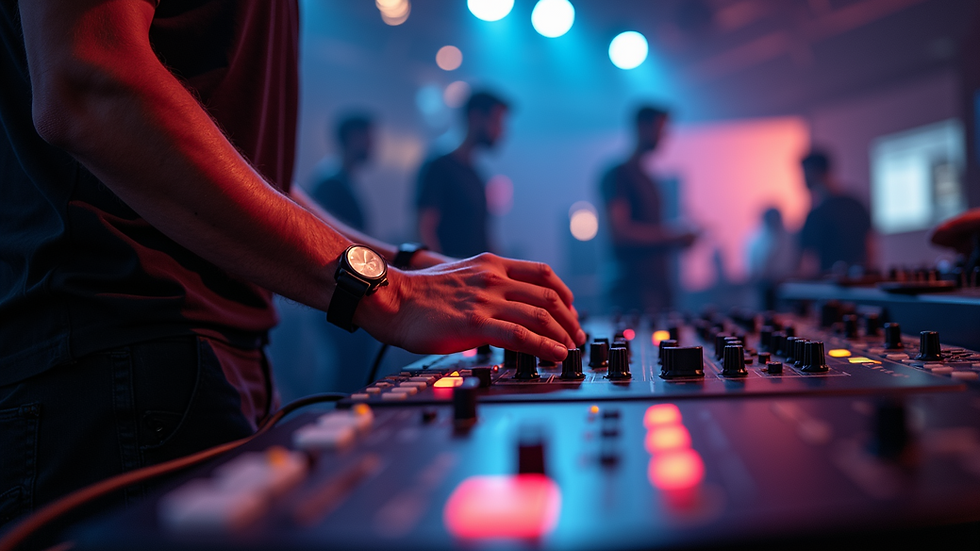Mastering the Essentials of Event Sound Setup
- Arson Lively
- Oct 8
- 3 min read
Setting up sound for an event can be a daunting task, especially if you want to ensure crystal-clear audio and a memorable experience for your audience. Whether you are organizing a small gathering, a corporate event, or a large concert, understanding the fundamentals of sound setup is crucial. This guide will walk you through the key components and best practices to master the essentials of sound setup for events.
Understanding Sound Setup for Events
Sound setup for events involves more than just plugging in microphones and speakers. It requires careful planning, knowledge of equipment, and an understanding of the venue's acoustics. The goal is to deliver clear, balanced sound that reaches every corner of the space without distortion or feedback.
Key Components of a Sound System
Microphones: Capture sound from speakers or performers.
Mixing Console: Controls audio levels and effects.
Amplifiers: Boost audio signals to drive speakers.
Speakers: Project sound to the audience.
Cables and Connectors: Connect all components reliably.
Venue Acoustics and Sound Placement
Every venue has unique acoustic properties. Hard surfaces reflect sound, while soft materials absorb it. Understanding these characteristics helps in positioning speakers and microphones to minimize echo and feedback.
For example, in a large hall with high ceilings, placing speakers at elevated positions and angling them towards the audience can improve sound distribution. In smaller rooms, closer speaker placement and using directional microphones can reduce unwanted noise.

Planning Your Sound Setup for Events
Proper planning is the foundation of a successful sound setup. Here are practical steps to ensure your event’s audio runs smoothly:
Assess the Venue
Visit the location beforehand.
Note the size, shape, and materials of the room.
Identify potential noise sources or reflective surfaces.
Determine Your Audio Needs
How many microphones are required?
Will there be live music, speeches, or both?
What is the expected audience size?
Choose the Right Equipment
Select microphones suitable for the event type (e.g., wireless for mobility).
Pick speakers with enough power to cover the venue.
Ensure the mixing console has enough channels for all inputs.
Setup and Testing
Arrive early to set up equipment.
Conduct sound checks with all performers or speakers.
Adjust levels and equalization to suit the environment.
By following these steps, you can avoid common pitfalls like feedback, uneven sound levels, or equipment failure.
What Sound System is Used in Concerts?
Concert sound systems are designed to handle large crowds and deliver powerful, high-quality audio. They typically include:
Line Array Speakers
These are tall stacks of speakers arranged vertically. They provide even sound coverage over long distances and reduce sound distortion.
Subwoofers
Subwoofers handle low-frequency sounds, adding depth and impact to music, especially in genres like rock or electronic dance music.
Digital Mixing Consoles
Modern concerts use digital mixers that allow precise control over multiple audio channels, effects, and wireless monitoring.
Monitor Speakers
Placed on stage, these allow performers to hear themselves clearly, which is essential for timing and pitch.
Wireless Microphones and In-Ear Monitors
Wireless systems provide freedom of movement, while in-ear monitors help performers hear a customized mix of the audio.

Concert sound engineers also use advanced software and hardware to manage sound delays, feedback suppression, and real-time adjustments, ensuring the best possible audio experience for thousands of attendees.
Tips for Effective Event Sound Setup
To elevate your event’s audio quality, consider these actionable recommendations:
Use Quality Cables and Connectors
Cheap or damaged cables can cause interference and signal loss. Invest in reliable, shielded cables.
Position Speakers Strategically
Avoid placing speakers too close to walls or corners to reduce bass buildup and echo.
Control Feedback
Use directional microphones and position them away from speakers. Employ equalizers to cut problematic frequencies.
Balance Audio Levels
Ensure vocals and instruments are balanced. Avoid overpowering bass or treble.
Have Backup Equipment
Always have spare microphones, cables, and batteries on hand.
Train Your Team
Make sure operators understand the equipment and can troubleshoot issues quickly.
Use Acoustic Treatment if Possible
Portable panels or curtains can help absorb excess sound reflections in challenging venues.

Enhancing Your Event with Professional Sound Setup
Mastering the essentials of sound setup can transform any event from ordinary to extraordinary. Whether you are a beginner or have some experience, continuous learning and practice are key. Consider consulting with professionals or renting high-quality equipment for larger events.
For those looking to dive deeper into the technical aspects or seeking expert assistance, exploring resources and services related to event sound setup can provide valuable insights and support.
By investing time in planning, understanding your equipment, and adapting to your venue, you can ensure your event’s audio is clear, impactful, and enjoyable for all attendees.






Comments